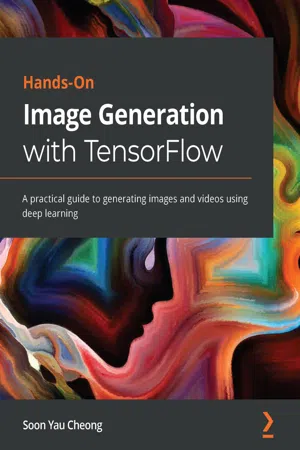
Hands-On Image Generation with TensorFlow
A practical guide to generating images and videos using deep learning
- 306 pages
- English
- ePUB (mobile friendly)
- Available on iOS & Android
Hands-On Image Generation with TensorFlow
A practical guide to generating images and videos using deep learning
About this book
Implement various state-of-the-art architectures, such as GANs and autoencoders, for image generation using TensorFlow 2.x from scratch
Key Features
- Understand the different architectures for image generation, including autoencoders and GANs
- Build models that can edit an image of your face, turn photos into paintings, and generate photorealistic images
- Discover how you can build deep neural networks with advanced TensorFlow 2.x features
Book Description
The emerging field of Generative Adversarial Networks (GANs) has made it possible to generate indistinguishable images from existing datasets. With this hands-on book, you'll not only develop image generation skills but also gain a solid understanding of the underlying principles.
Starting with an introduction to the fundamentals of image generation using TensorFlow, this book covers Variational Autoencoders (VAEs) and GANs. You'll discover how to build models for different applications as you get to grips with performing face swaps using deepfakes, neural style transfer, image-to-image translation, turning simple images into photorealistic images, and much more. You'll also understand how and why to construct state-of-the-art deep neural networks using advanced techniques such as spectral normalization and self-attention layer before working with advanced models for face generation and editing. You'll also be introduced to photo restoration, text-to-image synthesis, video retargeting, and neural rendering. Throughout the book, you'll learn to implement models from scratch in TensorFlow 2.x, including PixelCNN, VAE, DCGAN, WGAN, pix2pix, CycleGAN, StyleGAN, GauGAN, and BigGAN.
By the end of this book, you'll be well versed in TensorFlow and be able to implement image generative technologies confidently.
What you will learn
- Train on face datasets and use them to explore latent spaces for editing new faces
- Get to grips with swapping faces with deepfakes
- Perform style transfer to convert a photo into a painting
- Build and train pix2pix, CycleGAN, and BicycleGAN for image-to-image translation
- Use iGAN to understand manifold interpolation and GauGAN to turn simple images into photorealistic images
- Become well versed in attention generative models such as SAGAN and BigGAN
- Generate high-resolution photos with Progressive GAN and StyleGAN
Who this book is for
The Hands-On Image Generation with TensorFlow book is for deep learning engineers, practitioners, and researchers who have basic knowledge of convolutional neural networks and want to learn various image generation techniques using TensorFlow 2.x. You'll also find this book useful if you are an image processing professional or computer vision engineer looking to explore state-of-the-art architectures to improve and enhance images and videos. Knowledge of Python and TensorFlow will help you to get the best out of this book.
Frequently asked questions
- Essential is ideal for learners and professionals who enjoy exploring a wide range of subjects. Access the Essential Library with 800,000+ trusted titles and best-sellers across business, personal growth, and the humanities. Includes unlimited reading time and Standard Read Aloud voice.
- Complete: Perfect for advanced learners and researchers needing full, unrestricted access. Unlock 1.4M+ books across hundreds of subjects, including academic and specialized titles. The Complete Plan also includes advanced features like Premium Read Aloud and Research Assistant.
Please note we cannot support devices running on iOS 13 and Android 7 or earlier. Learn more about using the app.
Information
Section 1: Fundamentals of Image Generation with TensorFlow
- Chapter 1, Getting Started with Image Generation Using TensorFlow
- Chapter 2, Variational Autoencoder
- Chapter 3, Generative Adversarial Network
Chapter 1: Getting Started with Image Generation Using TensorFlow
- Understanding probabilities
- Generating faces with a probabilistic model
- Building a PixelCNN model from scratch
Technical requirements
Understanding probabilities
- Distribution
- Belief
Probability distribution
Table of contents
- Hands-On Image Generation with TensorFlow
- Why subscribe?
- Preface
- Section 1: Fundamentals of Image Generation with TensorFlow
- Chapter 1: Getting Started with Image Generation Using TensorFlow
- Chapter 2: Variational Autoencoder
- Chapter 3: Generative Adversarial Network
- Section 2: Applications of Deep Generative Models
- Chapter 4: Image-to-Image Translation
- Chapter 5: Style Transfer
- Chapter 6: AI Painter
- Section 3: Advanced Deep Generative Techniques
- Chapter 7: High Fidelity Face Generation
- Chapter 8: Self-Attention for Image Generation
- Chapter 9: Video Synthesis
- Chapter 10: Road Ahead
- Other Books You May Enjoy